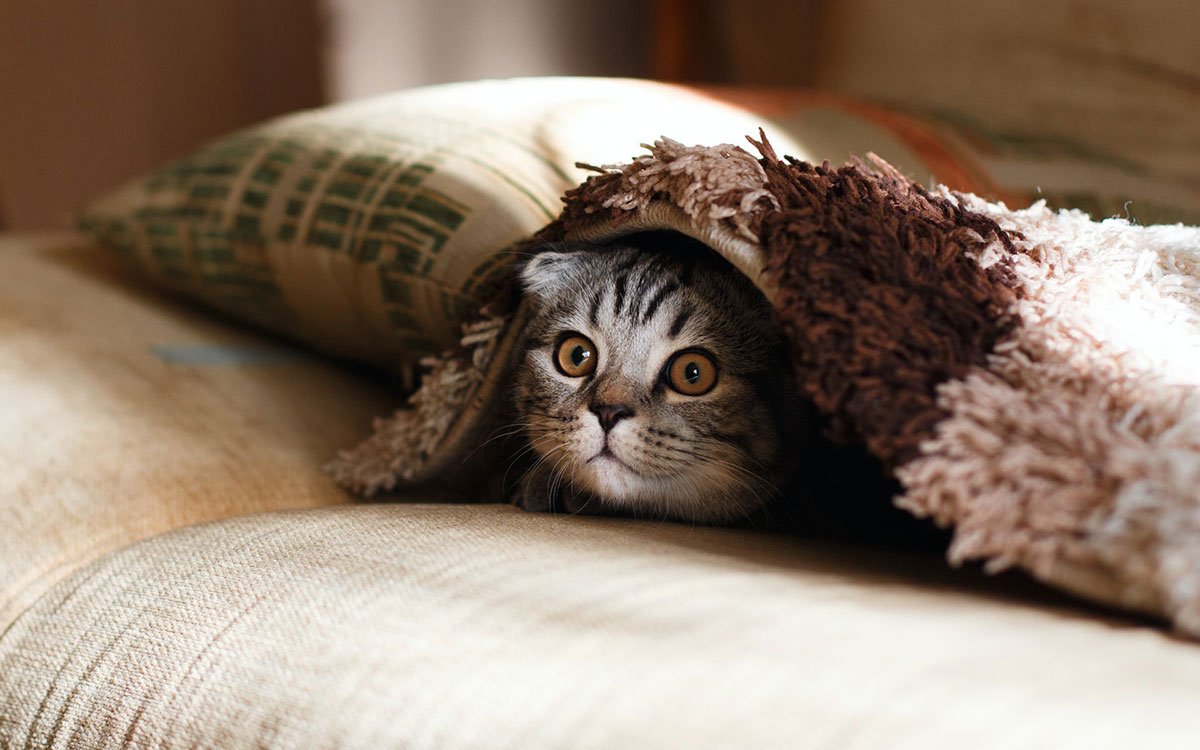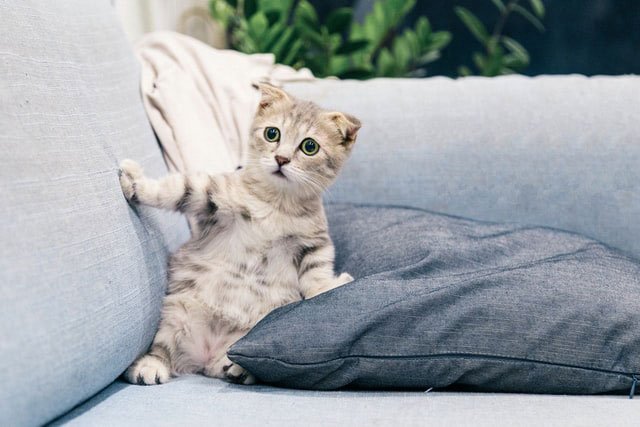Did you know that 83% of cat owners face behavior issues with their pets? These problems often come from a cat’s natural instincts and how they react to their surroundings. We’ll look at common cat behavior problems and how we can solve them as pet owners.
Key Takeaways
- Cat behavior problems are often a matter of perspective, with cats exhibiting natural behaviors that may conflict with our human expectations.
- Understanding feline instincts and environmental influences is key to addressing common issues like scratching furniture, litter box avoidance, and excessive meowing.
- Positive reinforcement training and environmental modifications can help manage cat behavior problems and create a harmonious living environment.
- Seeking professional help from veterinarians or animal behaviorists may be necessary for more complex or persistent behavior challenges.
- Maintaining realistic expectations and being patient with our feline friends can go a long way in resolving behavior issues.
Understanding Cat Behavior
To tackle common cat behavior problems, we need to understand what drives their actions. Cats have feline instincts that guide their natural behaviors like hunting and scratching. Their cat environmental needs and daily experiences also shape their cat behavior triggers.
Feline Instincts and Needs
Cats are driven by their instinctual behaviors, shaped by their history as solitary hunters. They have the urge to chase and scratch, and to mark their territory. Knowing these feline instincts helps us provide the right outlets for them to behave naturally and safely.
Environmental Influences on Behavior
Cats are also influenced by their cat environmental needs and daily experiences. Things like access to resources and social interactions shape their cat behavior triggers. Creating a safe, enriching environment helps solve behavior problems and strengthens our bond with them.
| Feline Instincts | Environmental Factors |
|---|---|
|
|
Understanding the connection between feline instincts, cat environmental needs, and cat behavior triggers helps us better understand our cats. This knowledge leads to more effective solutions for any behavior issues that come up.
Common Cat Behavior Problems
Scratching Furniture
Scratching furniture is a big problem for many cat owners. Cats scratch to remove old claw layers and mark their territory. It’s normal but can be upsetting when they scratch the couch or other items. Knowing why they do it and giving them the right places to scratch can help a lot.
Cats scratch for a few reasons:
- Removing the outer layer of their claws
- Marking their territory
- Stretching and exercising their muscles
To stop cat scratching furniture, give them scratching furniture or posts. These let them scratch naturally without harming your stuff. You can also use cat destructive behavior stoppers like sticky tape or citrus sprays on protected areas.
Understanding why they scratch and taking steps to manage cat scratching helps. It keeps your cat healthy and your home looking good.

“Providing your cat with appropriate scratching alternatives is key to managing this common cat behavior problem.”
Litter Box Avoidance
Litter box issues can be frustrating for cat owners. It’s important to remember that cats avoid litter boxes for their own reasons, not because of us. Cats are naturally clean and picky about where they go to the bathroom. If they start avoiding the litter box, it means something needs to change.
One big reason for this avoidance is a dirty or uncomfortable litter box. Cats want a clean, well-kept space for their bathroom needs. If the litter box isn’t cleaned regularly or the litter isn’t liked, they might look for other places. Scooping the litter box daily and changing it weekly can help fix litter box issues.
Medical problems, like urinary tract infections or kidney disease, can also cause cats to avoid the litter box. If your cat suddenly stops using it, take them to the vet to check for health issues.
- Stress and anxiety can also cause litter box training problems. Cats are sensitive and can get upset by changes.
- Make sure your cat has a comfortable, quiet, and secure place for the litter box. This can help them use it more often.
Finding and fixing the reason for your cat’s litter box avoidance is key. It keeps your home clean and your cat healthy. By understanding your cat’s needs and making the right changes, you can help them go back to their natural bathroom habits. This will make your relationship with your cat better.
| Common Reasons for Litter Box Avoidance | Solutions |
|---|---|
| Dirty or Uncomfortable Litter Box | Scoop daily, replace litter weekly |
| Medical Issues | Consult veterinarian for checkup |
| Stress and Anxiety | Provide a quiet, secure litter box location |
Excessive Meowing
Excessive cat meowing can be puzzling for pet owners. Cats are vocal, but too much meowing can strain relationships. Knowing why they meow and how to manage it is key to a better home life.
Reasons for Vocalization
Cats meow for many reasons, like attention, discomfort, or needs. Common reasons include:
- Hunger or thirst
- Loneliness or boredom
- Illness or pain
- Anxiety or stress
- Territorial marking
Managing Excessive Meowing
To reduce cat meowing, try these strategies:
- Find the cause: Watch your cat to see why they meow so much.
- Keep them busy: Give them toys, scratching posts, and comfy spots.
- Stick to a routine: Regular feeding, play, and sleep times help.
- Don’t give in: Ignore the meowing to stop it from getting worse.
- See a vet: If meowing doesn’t stop, check for health issues.
Understanding and managing cat meowing can make home life better for everyone.

Aggression and Biting
As cat owners, we know how important it is to handle aggressive behaviors like biting. Cats may act out due to fear, anxiety, or defending their territory. Understanding why they behave this way and training them helps make our homes safer for everyone.
Fear or anxiety often leads to cat aggression. Cats might feel scared by people or other animals, causing them to bite. We can make our cats feel safe by giving them cozy spots and introducing them slowly to new things.
Feline biting can also happen when cats feel their territory is being threatened. Cats are naturally protective of their space. We can help by setting clear boundaries and giving them things to scratch and play with.
Positive reinforcement is key in managing cat aggression. Rewarding calm behavior teaches cats to be friendly. Also, making changes to their environment, like adding hiding spots, can help reduce aggression.
Every cat is different, so it’s important to understand their needs and what makes them aggressive. By working with our cats and getting help when needed, we can make a safe and happy home for all.
Cat Anxiety and Stress
Just like humans, cats can feel anxious and stressed. These feelings can cause them to act out in ways that are hard for us to handle. It’s important to know the signs of anxiety and what might be causing it to help our pets feel better.
Identifying Anxiety Triggers
Cats can get anxious or stressed for many reasons. Some common things that might upset them include:
- Changes in routine, such as a new schedule or the absence of a family member
- Unfamiliar surroundings or the introduction of new objects in the home
- Interactions with unfamiliar people or animals
- Loud noises or sudden changes in sound levels
- Lack of adequate resources, such as litter boxes, scratching posts, or hideaways
By identifying cat anxiety triggers, we can understand why our cats might be acting differently. This helps us find ways to make them feel better.
| Potential Anxiety Trigger | Potential Behavioral Responses |
|---|---|
| Changes in Routine | Increased vocalization, decreased appetite, litter box avoidance |
| New Environments | Hiding, excessive grooming, aggression |
| Lack of Resources | Destructive scratching, territorial marking, reduced activity |
Knowing what might upset our cats and how they might react helps us create a better home for them. We can make sure they have everything they need to feel safe and happy.

Indoor Cat Misbehavior
Cats that stay indoors all the time might act out because they’re bored or lack stimulation. They might meow too much, scratch things they shouldn’t, or get more aggressive. To keep them happy, it’s important to make their home interesting and fun.
Providing Enrichment
To stop indoor cat misbehavior, you need to make their space engaging. Here are some ways to enrich your indoor cat’s life:
- Interactive toys: Use puzzle feeders, toys that give treats, and wand toys to make them hunt and play.
- Cat trees and scratching posts: Give them places to scratch, climb, and sit, meeting their natural needs.
- Window perches: Let them watch birds and see the outside world, which is good for their mind.
- Regular playtime: Spend time each day playing with them, using toys that mimic prey like feathers or laser pointers.
- Hiding spots: Create small, safe places for them to hide and feel secure, reducing stress.
By adding these enrichment activities, you can manage indoor cat behavior problems. This keeps them both mentally and physically healthy.
“Providing an enriching environment is crucial for the well-being of indoor cats. It helps them express their natural behaviors and prevents the development of unwanted misbehaviors.”
Understanding your cat’s needs is key to managing indoor cat misbehavior. Give them the cat enrichment they need to thrive indoors.
Destructive Behavior in Cats
We love our cats, but their natural instincts can sometimes lead to destructive behaviors. These can include scratching furniture and chewing on household items. But, with the right approach, we can manage and curb these tendencies.
The main reason for cat destructive behavior is their need to fulfill physical and psychological needs. Scratching helps cats keep their claws healthy and mark their territory. Chewing is often a way for cats to deal with boredom or stress.
Understanding why cats behave destructively and using the right cat behavior modification techniques is key. We can do this by providing scratching posts, engaging them in play, and enriching their environment with toys and activities.
With patience, positive reinforcement, and the right management of cat destructive tendencies, we can help our cats behave better. This way, we can create a happier and more well-adjusted feline companion.
“The key to managing destructive cat behavior is to understand the underlying reasons and provide appropriate outlets for their natural instincts.”
Identifying and Addressing Destructive Behaviors
The first step in managing cat destructive behavior is to identify the specific behaviors that are causing issues. Some common destructive behaviors in cats include:
- Scratching furniture or other household items
- Chewing on plants, cords, or other non-food items
- Excessive digging or burrowing in indoor environments
- Aggressive behavior, such as biting or swatting
Once we know the problematic behaviors, we need to address the underlying causes. This can involve providing the right outlets for their natural instincts, like scratching posts and toys. Positive reinforcement training can also help discourage bad behaviors and encourage good ones.
| Destructive Behavior | Potential Causes | Management Strategies |
|---|---|---|
| Furniture Scratching | Natural claw maintenance, marking territory | Provide scratching posts, trim nails, use deterrents |
| Chewing on Non-Food Items | Boredom, stress, dental issues | Offer chew toys, increase playtime, address underlying causes |
| Aggressive Behavior | Fear, anxiety, territoriality, pain | Identify triggers, provide a safe environment, consult a veterinarian |
By addressing the root causes of cat destructive behavior and using the right management strategies, we can help our cats thrive. This protects our homes and belongings while ensuring our feline friends are happy and healthy.

Cat Behavior Problems from Human Perspective
Many “cat behavior problems” come from our own views. Cats act naturally, but this might not match our expectations. By seeing things from their side, we can solve these issues better.
Cats follow their instincts, which can sometimes conflict with our homes. Empathizing with cat behavior helps us tackle “problem” behaviors. Only by understanding feline behavior can we really fix the issues.
“The cat is a mysterious creature, and the more I learn about them, the more I realize how little I know.” – Compton Mackenzie
Cats aren’t always acting out. They’re just following their instincts. It’s our job to make a home that fits their needs. By changing how we see cat behavior, we can have a better relationship with them.
The solution to cat behavior issues is understanding and empathy. With patience and creativity, we can make a home that suits our cats. This way, we can reduce so-called “behavior problems.”
Addressing Behavior Issues
When dealing with cat behavior issues, a mix of positive reinforcement and environmental changes works well. Positive reinforcement rewards good behavior, shaping our cats’ actions. Also, adjusting their living space, like providing scratching surfaces or hiding spots, can solve many problems.
Positive Reinforcement Training
Positive reinforcement training is a key tool for fixing cat behavior issues. By rewarding our cats for good behavior, we encourage them to do it again. This method is better than punishment, which can cause fear and anxiety.
- Use treats, praise, and playtime as rewards for desired behaviors.
- Be consistent and patient when training, as it can take time for cats to learn new habits.
- Focus on teaching alternative behaviors, such as scratching on appropriate surfaces, rather than simply prohibiting the undesirable behavior.
Environmental Modifications
Creating the right environment for our cats is key to preventing and managing behavior problems. Meeting their basic needs and enriching their space can reduce issues like scratching, excessive meowing, or inappropriate elimination.
| Environmental Enrichment Strategies | Benefits |
|---|---|
| Offer a variety of scratching posts and pads | Redirects natural scratching behavior to appropriate surfaces |
| Provide hiding spots and vertical perches | Fulfills a cat’s need for security and exploration |
| Introduce interactive toys and rotate them regularly | Stimulates a cat’s natural hunting and play instincts |
By using positive reinforcement training and environmental enrichment for cats, we can tackle many cat behavior issues. This helps our feline friends live happily in their home environment.

Managing Expectations
As cat owners, it’s key to have realistic expectations about our feline friends’ behavior. Cats have instincts and needs that might not match our wishes. By managing our expectations, we can avoid frustration and build a better bond with them.
Understanding the feline nature helps us grasp cat behavior. Cats are independent and solitary hunters. They behave based on their instincts. So, instead of wanting them to act like dogs or humans, we should accept their unique traits and meet their needs.
Realistic cat ownership means knowing that some behaviors, like scratching furniture or meowing a lot, are natural. By setting achievable goals and working with their natural tendencies, we can make our cats happier and our relationship better.
“The secret to understanding cat behavior is to see the world through their eyes and appreciate their unique perspective.”
Managing expectations for cat behavior is vital for our pets’ well-being and a strong bond. By embracing their nature and creating a suitable environment, our cats will thrive. And we’ll get to enjoy their company fully.
| Unrealistic Expectations | Realistic Expectations |
|---|---|
| Cats should behave like dogs or humans | Cats have unique behaviors and instincts |
| Cats should never scratch furniture or vocalize | Some scratching and meowing are natural behaviors |
| Cats should always be affectionate and cuddly | Cats have varying personalities and need their own space |
When to Seek Professional Help
As cat owners, we try our best to solve any behavioral issues our cats face. Sometimes, we need to call in a cat behavior specialist or a veterinarian. If we’ve tried many ways to fix the problem but it doesn’t get better, it’s time to get help.
A certified cat behavior specialist can offer great advice. They help us find out why our cat is acting out and suggest better ways to handle it. They can also check for any health problems that might be causing the bad behavior. A veterinary consultation for cat behavior is also key to making sure there’s no health issue and to create a plan to fix the problem.
Getting professional help lets us understand our cat’s needs better. We can learn how to train them or change their environment to help them feel better. Don’t be afraid to ask for help when you need it. Experts can really help solve cat behavior problems.
| When to Seek Professional Help | Benefits of Professional Assistance |
|---|---|
|
|

“Seeking professional help is often the best way to address persistent or worsening cat behavior problems. Their expertise can make a significant difference in the well-being of both you and your feline companion.”
Cat Training Tips
Effective cat training is key to solving behavior issues and strengthening our bond with them. Positive reinforcement helps shape their behavior and deepens our connection. Building trust with our cats makes training and behavior changes more effective.
Building a Bond
Creating a strong bond with your cat is the first step in training. Spend quality time with your cat, playing, giving treats, and showing gentle affection. This makes your cat feel safe and more open to your guidance. Positive reinforcement, like treats or praise for good behavior, builds trust and cooperation.
- Engage in regular play sessions to strengthen the bond
- Offer treats as a reward for good behavior
- Provide gentle petting and affection to foster a sense of security
Cats are unique, and understanding their personalities and needs is crucial. By using positive reinforcement for cats, you’ll build a strong bond. This leads to successful cat training tips and a closer relationship with your cat.
“The best way to have a friend is to be one.” – Ralph Waldo Emerson
Correctly interpreting cat body language
Conclusion
Understanding cat behavior problems from a human point of view is key. It helps us tackle common issues. By knowing why cats act certain ways, we can enrich their environment and use positive training. This way, we build a better cat-human relationship.
By getting into cat psychology and their needs, we can solve behavior problems. We learn about their instincts and what affects their actions. This knowledge helps us find kind and effective solutions, making our bond stronger.
The main thing is to understand and connect with our cats. By creating a positive space, we deepen our bond. This leads to a more joyful life together for both humans and cats.
FAQ
What are the most common cat behavior problems?
Common cat behavior problems include scratching furniture and avoiding the litter box. Cats may also meow too much, show aggression, or exhibit anxiety. They might chew or dig on things they shouldn’t.
Why do cats scratch furniture?
Cats scratch to remove old claw layers and mark their territory. Giving them scratching posts can help them avoid furniture.
What causes litter box problems in cats?
Cats might avoid the litter box if it’s dirty or uncomfortable. Medical issues or stress can also cause this problem. Finding and fixing the cause is key.
Why do some cats meow excessively?
Cats meow for many reasons, like needing attention or feeling uncomfortable. Understanding why they meow helps us manage it better.
How can we manage cat aggression and biting?
To manage aggression, address the underlying causes like fear or territory protection. Proper training and socialization can help make the environment safer.
What are the signs of cat anxiety and stress?
Changes in routine or new environments can stress cats. Recognizing these signs and finding the triggers is important for helping them.
How can we prevent indoor cats from misbehaving?
Keep indoor cats happy with enrichment activities like toys and cat trees. Regular playtime also helps prevent misbehavior.
What are some effective ways to address destructive cat behaviors?
Understanding why cats behave destructively helps. Use training and environmental changes to manage scratching, chewing, or digging.
When should we seek professional help for cat behavior problems?
If problems don’t improve with home solutions, seek a cat behavior specialist or vet. They offer expert advice and solutions.
What are some effective cat training tips?
Positive reinforcement and building trust are key. This approach makes training and behavior changes more effective.






